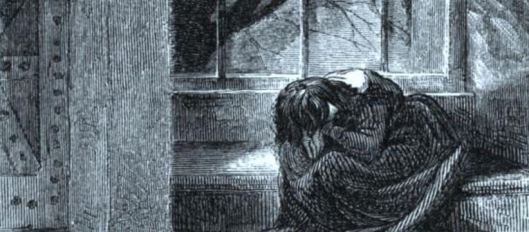There are but few children, in this matter-of-fact age, who have real faith in the jolly little man with mouse-skins and reindeer…
No this wasn’t written in 2012. This is taken from the children’s book Keep a Good Heart: A Story for Christmas Time by Cousin Carrie 1864 p. 78.
What can children’s books tell us about the culture and the values of the period?
Civil War children’s books were written with the overt intention of providing a model of exemplary behavior for children to follow. Stories of the period are founded on the power of obedience and faith and redemption as a requisite for happiness and success. Books written for the northern audience often featured anti-slavery elements. For today’s reader these books are sources for information on food preparation, visiting customs, daily economy, class and racial prejudices, clothing, parenting, and holiday celebrations.
If you should decide to peruse some of the many volumes now available on Google Books or the Gutenberg Project, do not expect high literature. Cousin Carrie (a pseudonym) and her ilk were not Dickens nor Alcott. Moral themes are hammered. Plots are simplistic. Stereotypic too-good-to-be-true heroes and heroines, often orphaned or responsible for caring for a sick parent, suffer, survive, and triumph with hard work, faith in God, and often, a surprising beneficence on the part of some noble rich person. The style is overwhelmingly tilted toward melodrama and pathos. If something can go wrong it does and every upswing in the hero’s life is met with a crashing down swing. However, the prose is usually very readable, and there is plenty of conflict and tension to keep you reading.
Keep a Good Heart is a good example of a typical Civil War era children’s novel and like others starts off with two orphaned girls who must make their way alone in the world. As females, their options in this male-dominated period are limited. The older sister finds work in New York City sewing, but earns barely enough to survive on. An economic downturn leaves her unemployed and her little sister ends up hawking her sister’s sewing on the street. When her sister falls ill and is hospitalized, the little girl is befriended by a blind Italian immigrant organ grinder and a black ex-slave who help her despite their own poor state and teach her the true meaning of charity. It ends of course, happily ever after with a thankful prayer.
If we leave the uplifting story of Lillian and Eva behind, we start to unearth the real historical treasures in this book. The book begins in a small rural town, we get a view of the school-house and life in a small cottage. Then it switches to New York City. Our heroine Lillian with her little sister Eva boards with a lower middle class family, works as a milliner and a seamstress. Eva compares the country school with the NYC public one. We experience the effect of a recession on small business people and the poor. We visit a china store and toy stores, a tenement and a hospital. Along the way we dine on sponge cake and a roast turkey shipped from the village to NYC in a crate [the winter cold was considered refrigeration enough] and reheated in a coal stove, see a coal fire built in a small ceramic fireplace in a tenement, learn the trials and tribulations of street vendors, and see a Christmas tree in a wealthy home, a custom not known to the poorer characters, decorated with candles, glass balls, and homemade decorations. All described in clear detail.
What a treasure for the Civil War historian, novelist, or a teacher who wants to introduce their students to life during the time.
Here are some links to other Christmas stories from the period that can be downloaded as EPUB or PDF.
- Contraband Christmas by Nathaniel Root 1864
- The Orphan’s Home Mittens by Aunt Fanny 1863
- Winnie and Walter’s Christmas Stories by Increase Niles Tarbox 1861
Note: There is an illustration of children hitting something like a pinata – see below, which is not named in the text of Keep a Good Heart. A brief search indicated that hitting a candy-filled object was popular at Christmas in Europe from Medieval times. In Denmark it’s called Hitting the Cat in the Barrel. Does anyone know the name of this game during the 1800s in the US?
If you find any other Civil War children’s novels that tell Christmas stories. please share.



This is a perfect guide to using primary sources to teach historical thinking!
LikeLike
So often when we think Civil War we think only about soldiers and the war. And while the war was terrible, everyday lives still went on. I think children’s literature is a great way to learn about every day people, and it is something very accessible for our students. These books download as PDFs and EPUB which can be read on tablets, computers, and Smartboards. A great lesson for upper levels would be to compare one of these novels to the novels students read today.
LikeLike
The NYTheater Workshop is performing “A Civil War Christmas” this Nov. and Dec.
LikeLike
Thanks for letting us know. Here it the link for tickets. http://www.nytw.org/season.asp
LikeLike